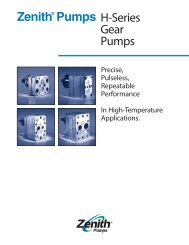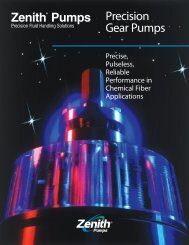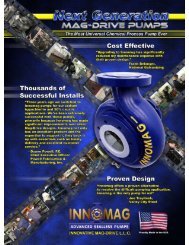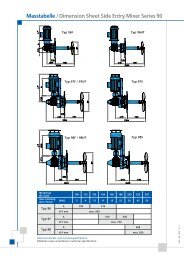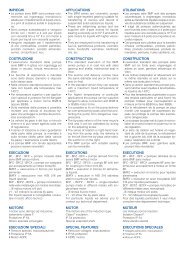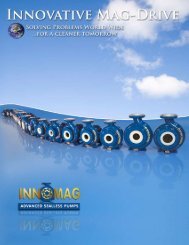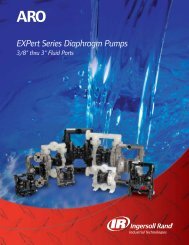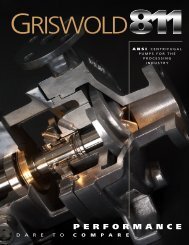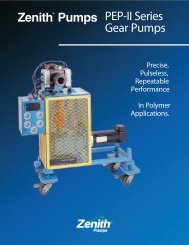Planetary Gear Pumps - LUBOSA
Planetary Gear Pumps - LUBOSA
Planetary Gear Pumps - LUBOSA
Create successful ePaper yourself
Turn your PDF publications into a flip-book with our unique Google optimized e-Paper software.
Pump Selection<br />
The following is a general guide<br />
for use with the tables in this catalog<br />
in selecting a spin pump for most textile<br />
denier, melt polymer applications.<br />
If the pump models described in this<br />
catalog are not suitable for your particular<br />
needs, Zenith <strong>Pumps</strong> has more<br />
than 1,000 additional spin pump<br />
designs as well as extensive custom<br />
engineering and manufacturing capability<br />
to provide an optimum pump for<br />
almost any fiber spinning application.<br />
Beyond the technical data included in<br />
this catalog, Zenith <strong>Pumps</strong> can provide<br />
pump performance curves for<br />
each pump model describing the volumetric<br />
efficiency, operating torque,<br />
and temperature rise for any customer<br />
specified polymer. Finally, before placing<br />
your order, please confirm your<br />
pump selection with either the Zenith<br />
factory or your Zenith <strong>Pumps</strong> sales<br />
representative.<br />
1) Choose a pump model from the<br />
table on opposite page based on your<br />
requirements for: number of metered<br />
output streams, inlet and outlet operating<br />
pressures, and maximum polymer<br />
viscosity. Additionally, in the case of 6<br />
or 8 stream models, select either the<br />
single gear level or the dual gear level<br />
model based on your available installation<br />
space and/or the anticipated<br />
range in throughput.<br />
2) Divide your design pumping<br />
rate per outlet stream expressed in<br />
cm 3 /minute by each of the displacements<br />
available for the selected<br />
model (see catalog page for each<br />
pump model) to determine the pump<br />
speed for each displacement. For the<br />
best overall performance, select the<br />
pump displacement that results in a<br />
pump speed within the following<br />
optimum ranges.<br />
• 10-27 rpm for 2, 3, 4, dual level 6,<br />
and dual level 8 stream models<br />
• 8-18 rpm for single level 6 stream<br />
models<br />
• 6-14 rpm for single level 8 stream<br />
models<br />
Steps 3 through 6 are used to verify<br />
the mechanical torque adequacy of<br />
the pump selected in step 2. If the<br />
pump is found to be acceptable, the<br />
calculated operating torque from step<br />
5 can be used to size the pump drive.<br />
3) Apply the maximum anticipated<br />
pump speed in rpm (N), and the<br />
pump (K 1 ) factor (see catalog page<br />
for pump model) to the following<br />
equation and calculate the average<br />
shear rate (SR) in the pump in sec -1 .<br />
SR = N * K 1<br />
4) Using this shear rate and a viscosity<br />
versus shear rate curve for the<br />
spin polymer at the process temperature,<br />
determine the apparent viscosity<br />
for the polymer (µ) in Poise. Note:<br />
Poise = 10 * Pa-s.<br />
5) Apply the number of metered<br />
streams (n), the pump displacement<br />
per stream (D), the required pump differential<br />
pressure in bar (∆P =<br />
Discharge - Inlet, note: bar = 14.5 *<br />
psi), the maximum anticipated pump<br />
speed in rpm (N), the apparent viscosity<br />
(µ) in Poise, and the pump (K 2 )<br />
factor (see catalog page for pump<br />
model) to the following equation and<br />
calculate the pump operating torque<br />
(T) in N-m. Note: in-lbs = 8.85 * N-m.<br />
T = ( n * D * ∆P/62 ) + ( N * µ/K 2 )<br />
6) Compare this calculated value<br />
with the mechanical torque limit for the<br />
pump model (see catalog page for<br />
pump model) to verify the adequacy<br />
of the selected pump.



